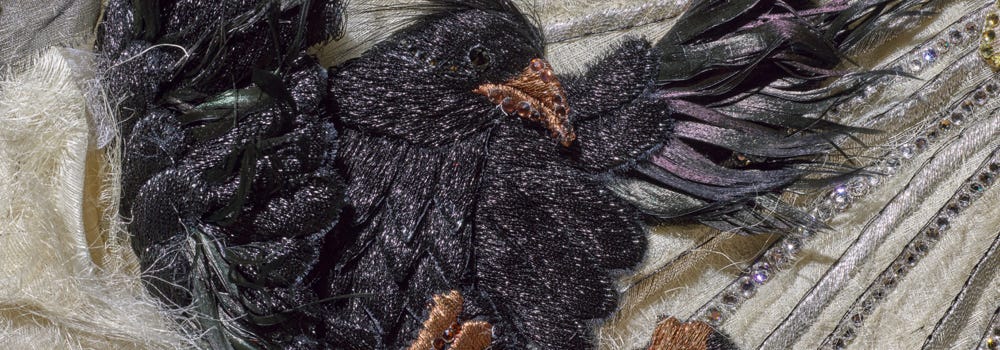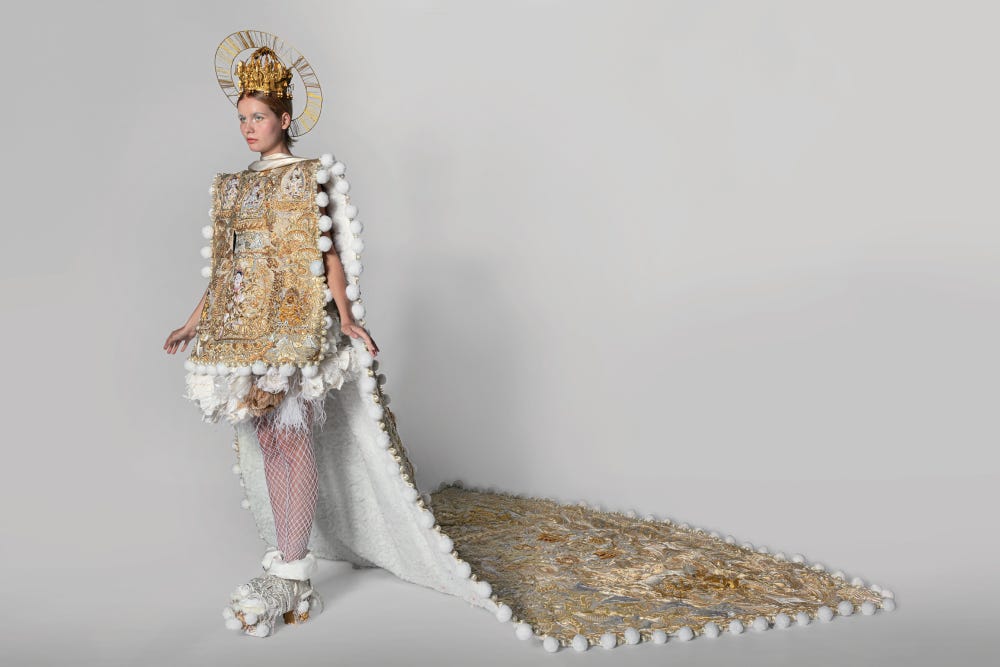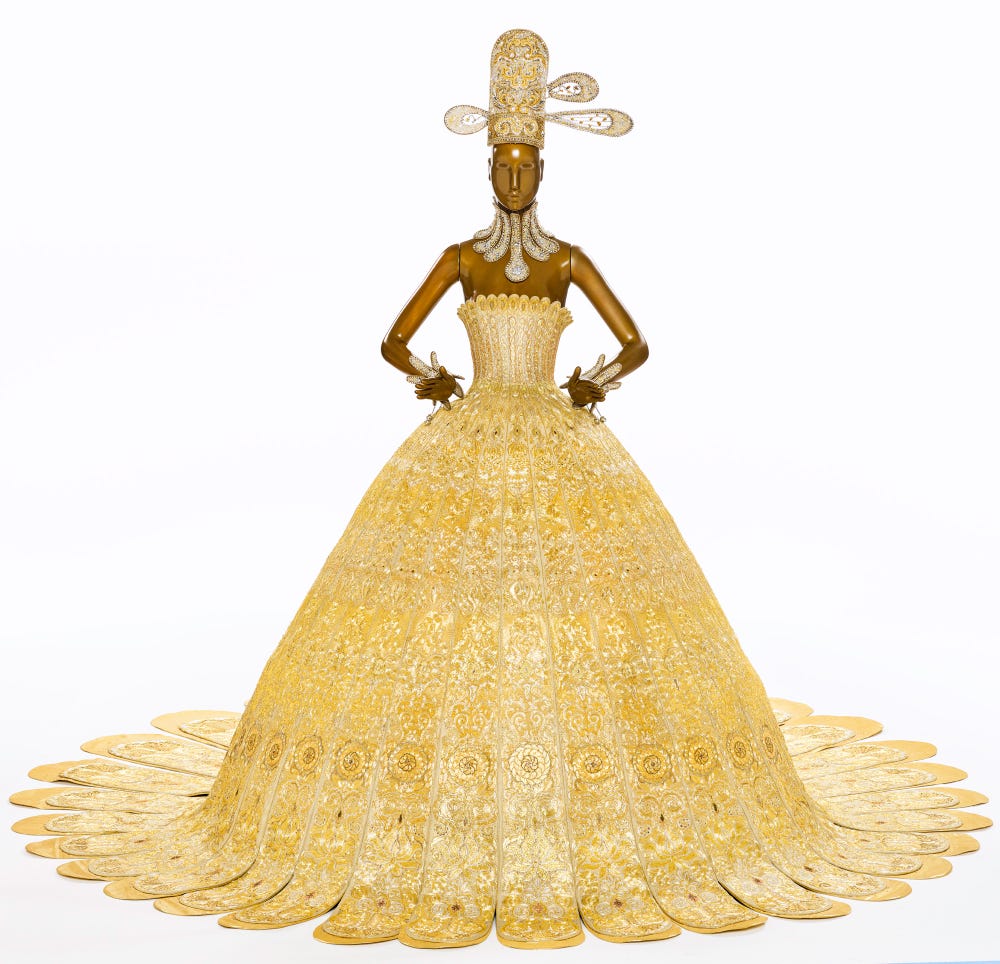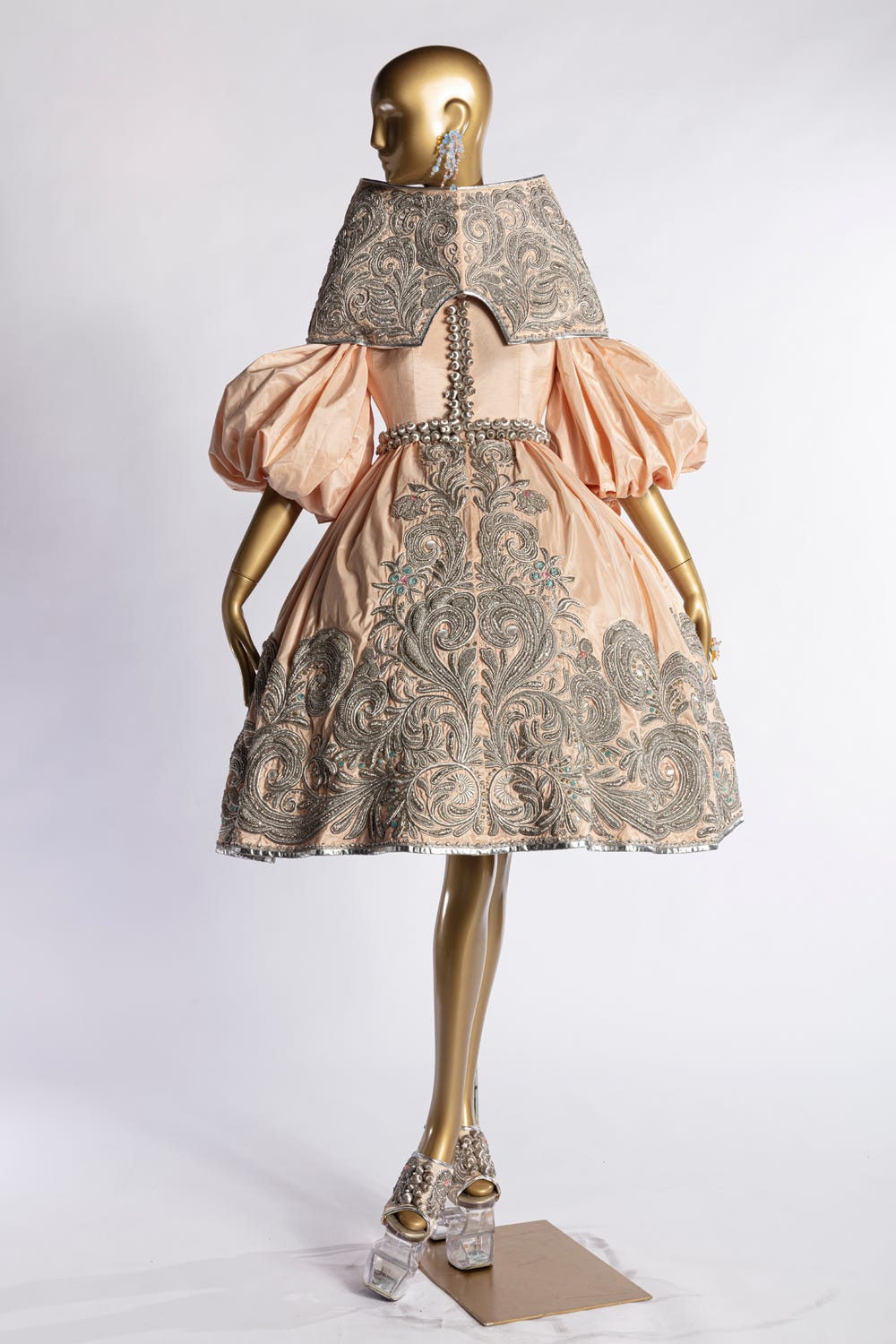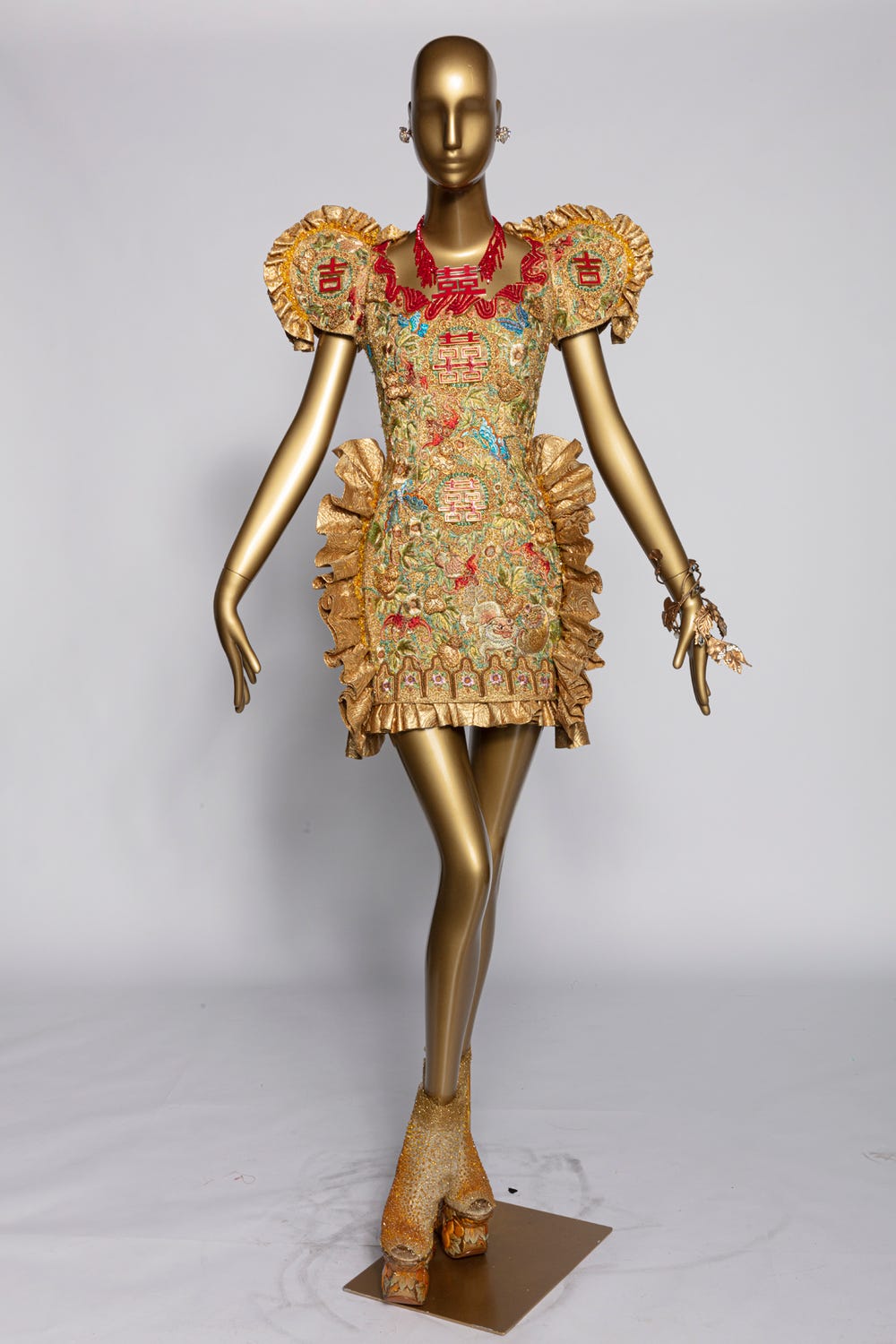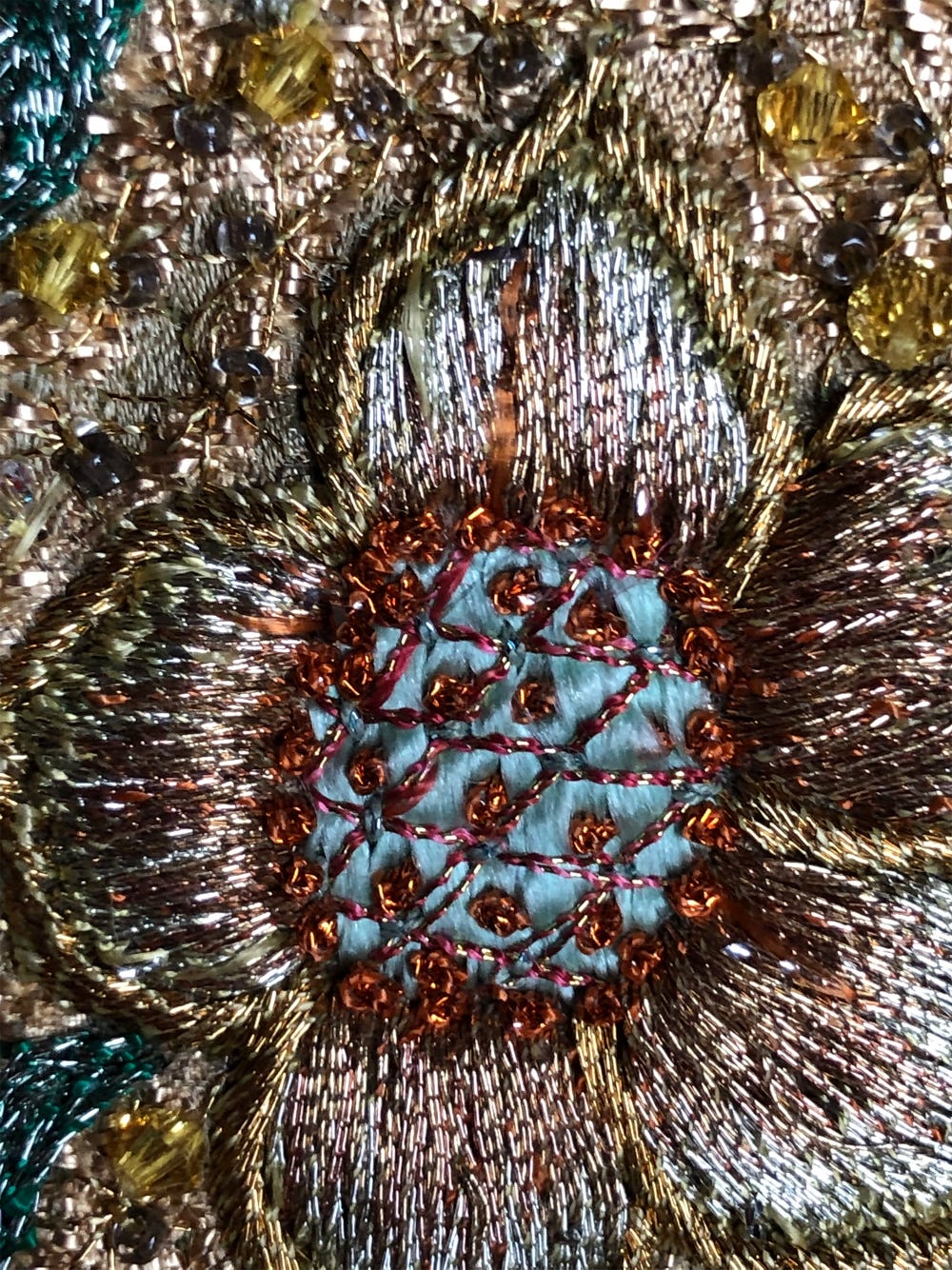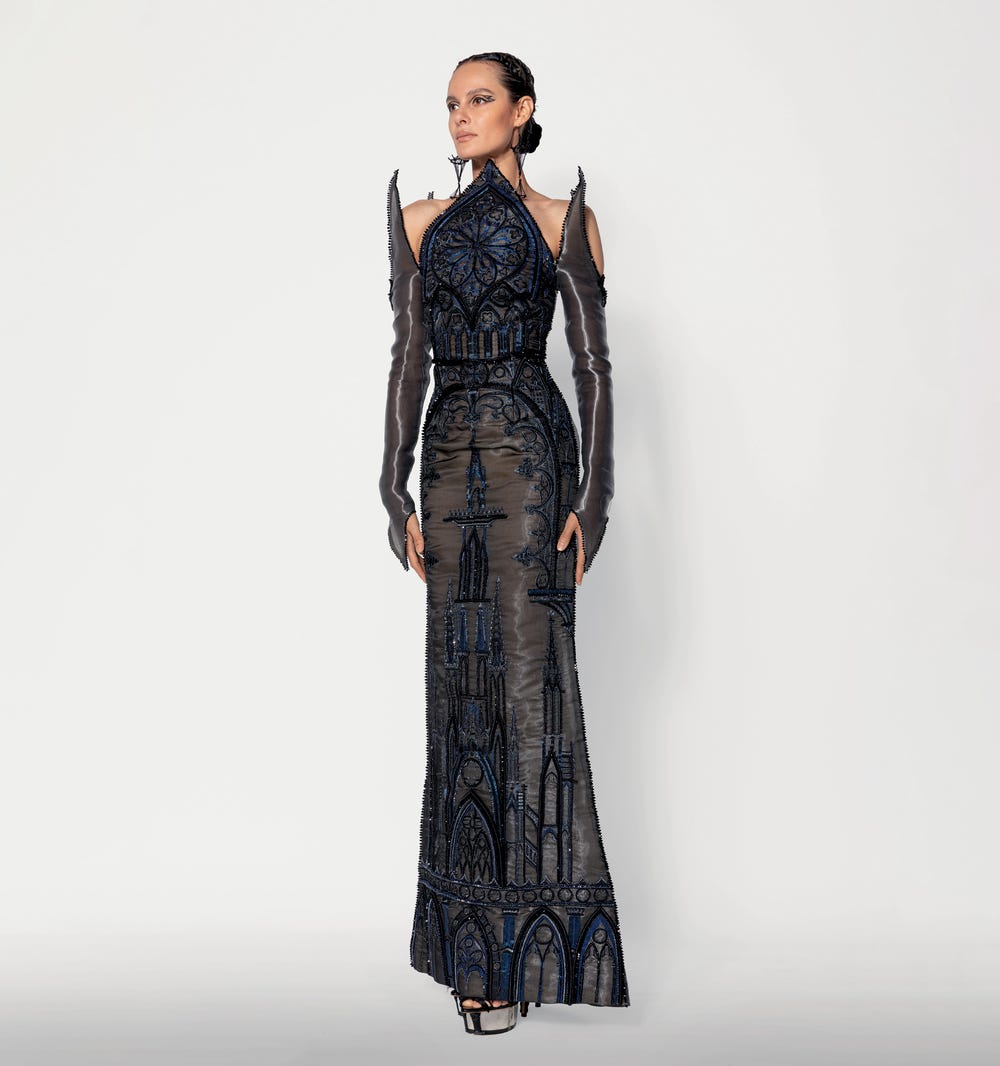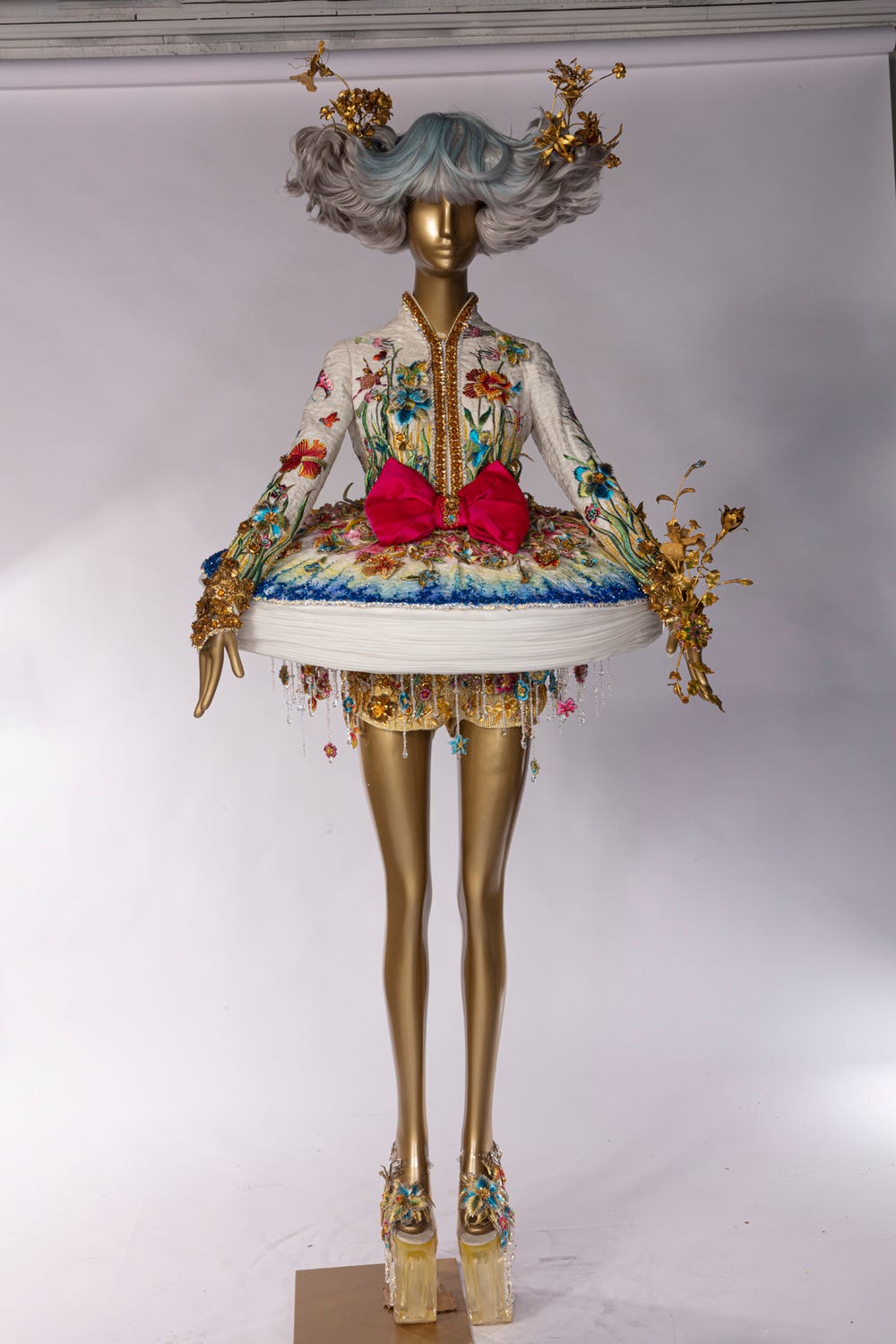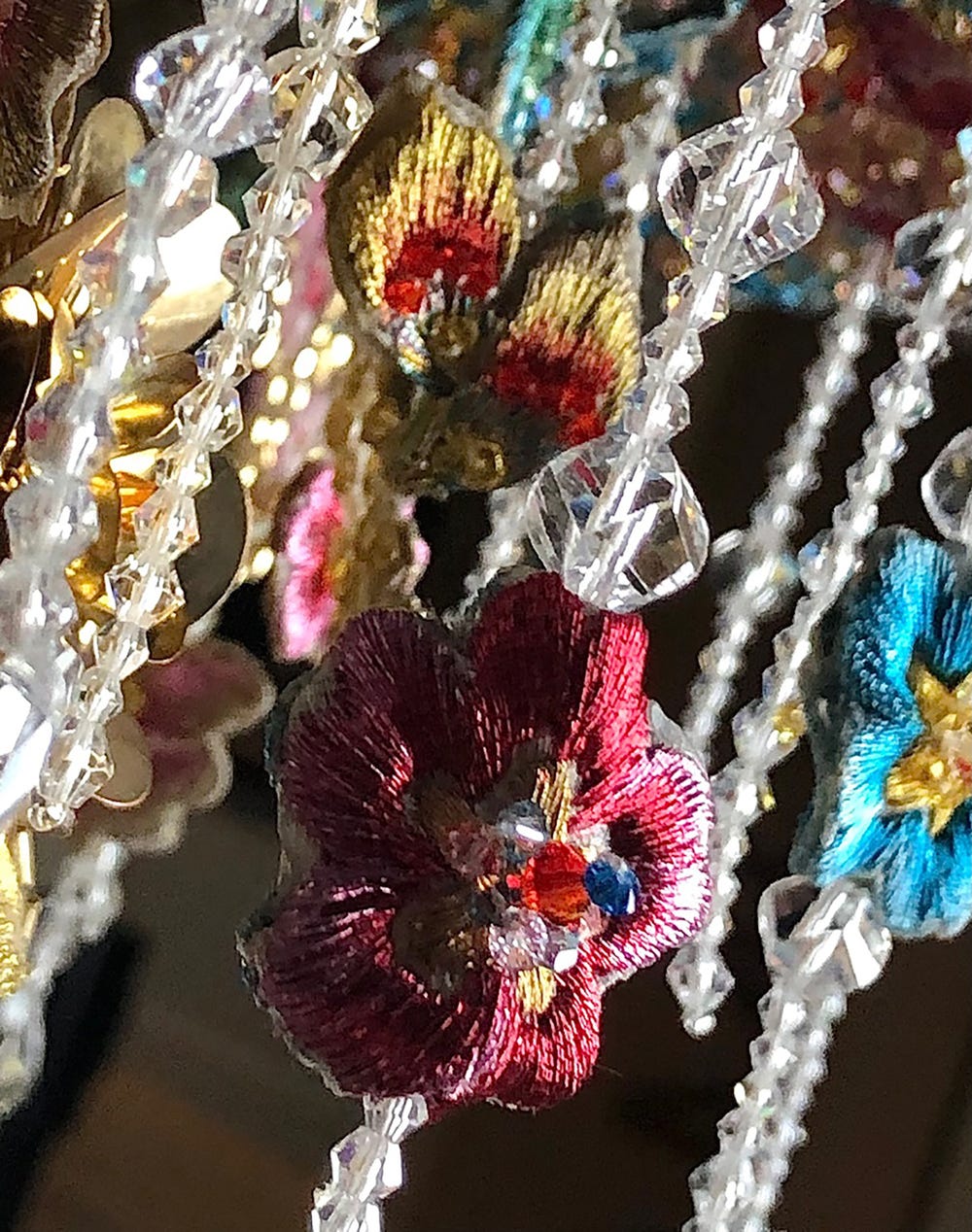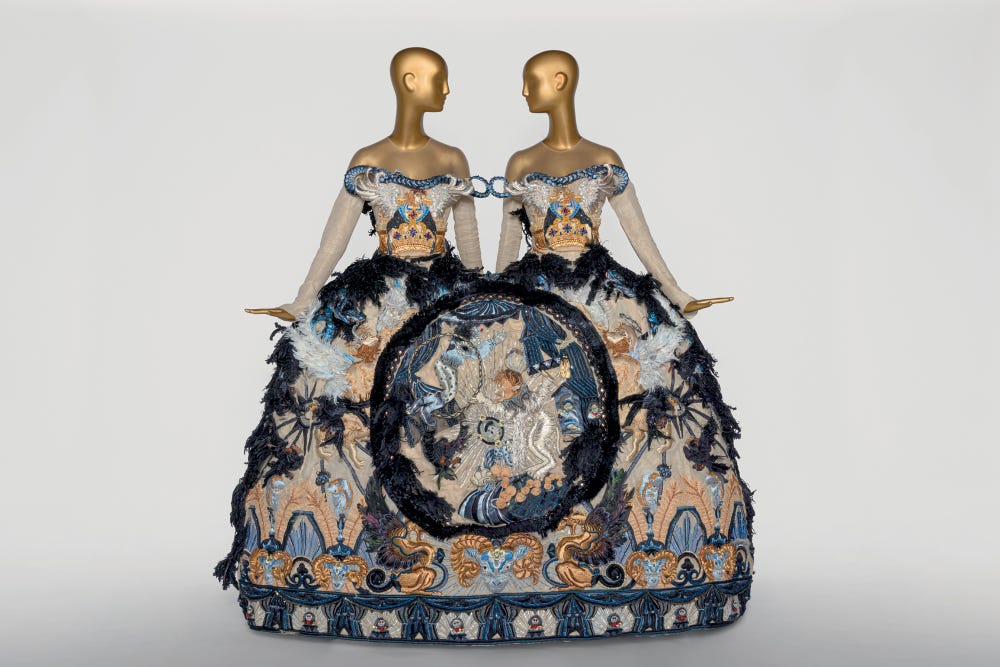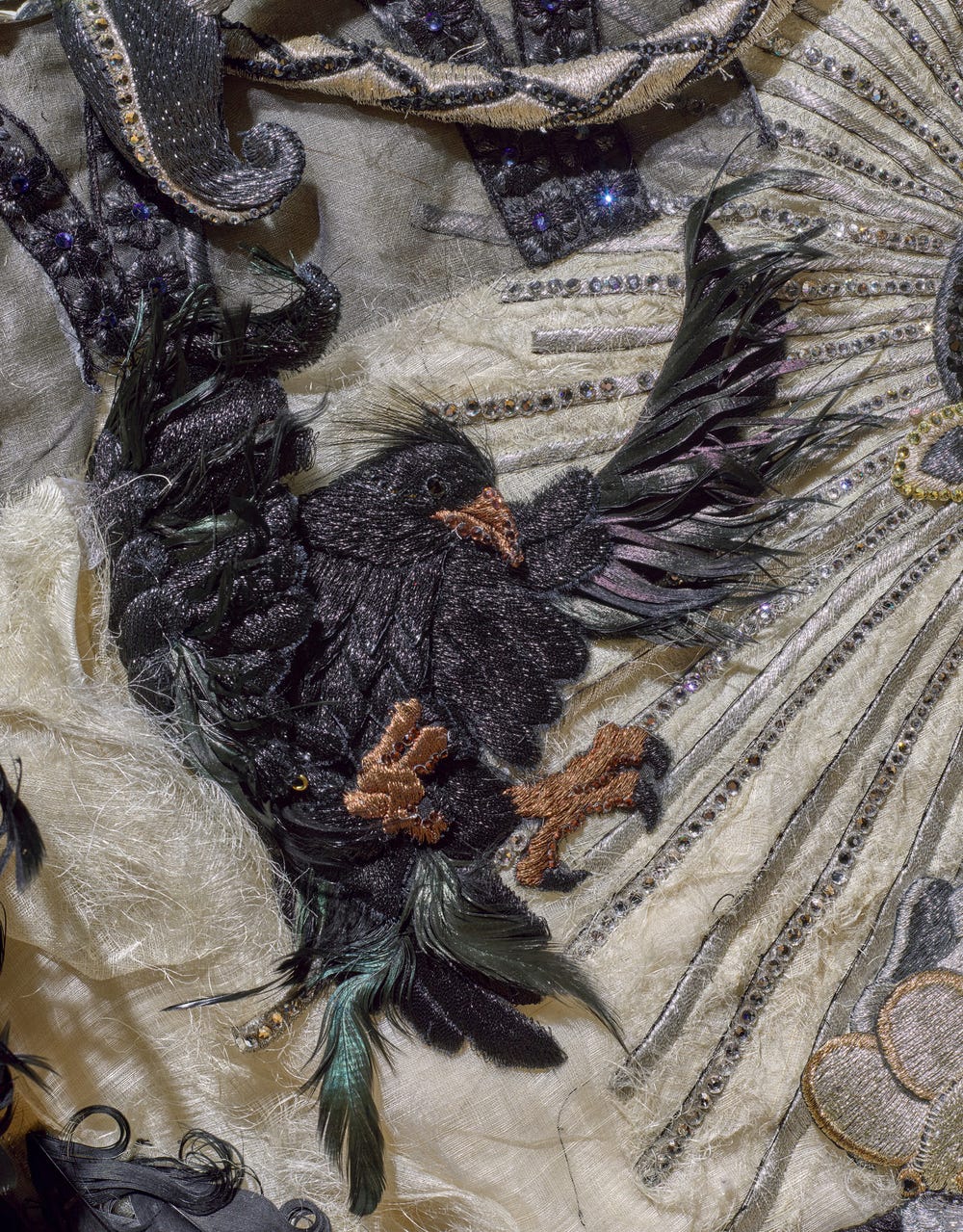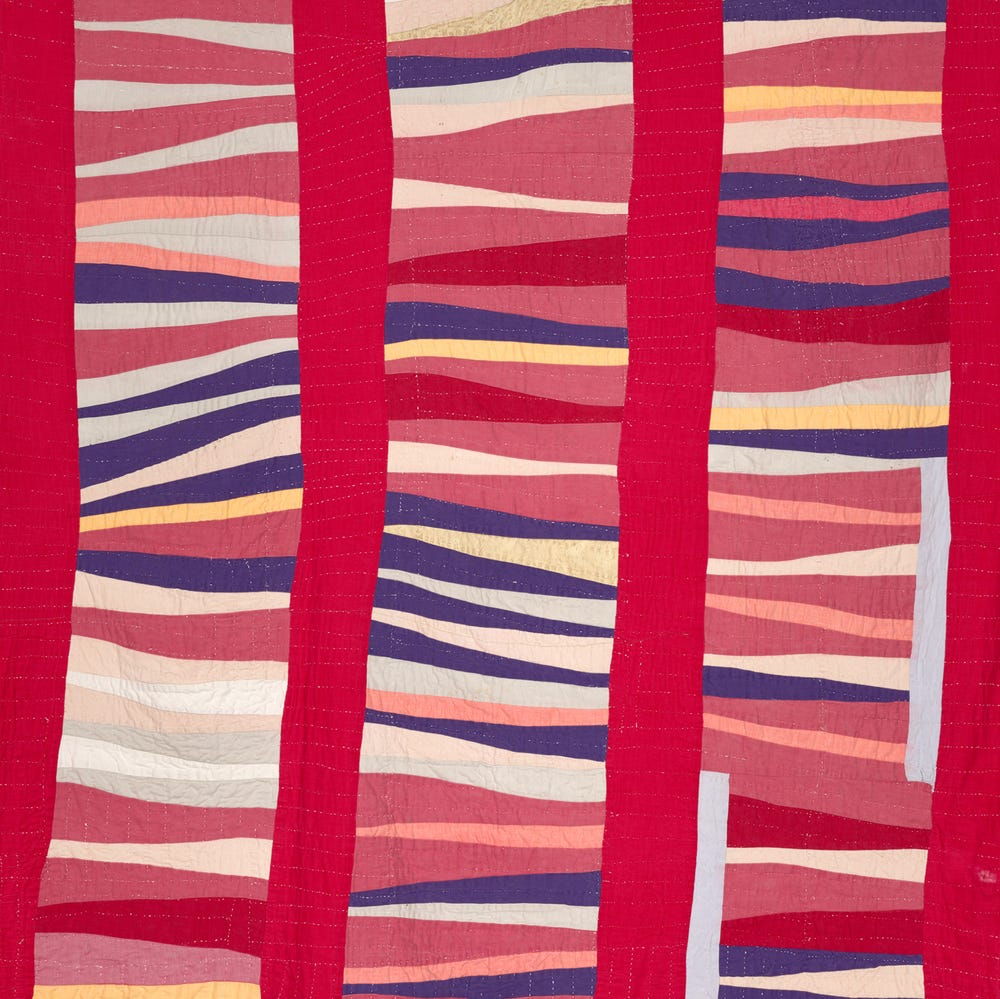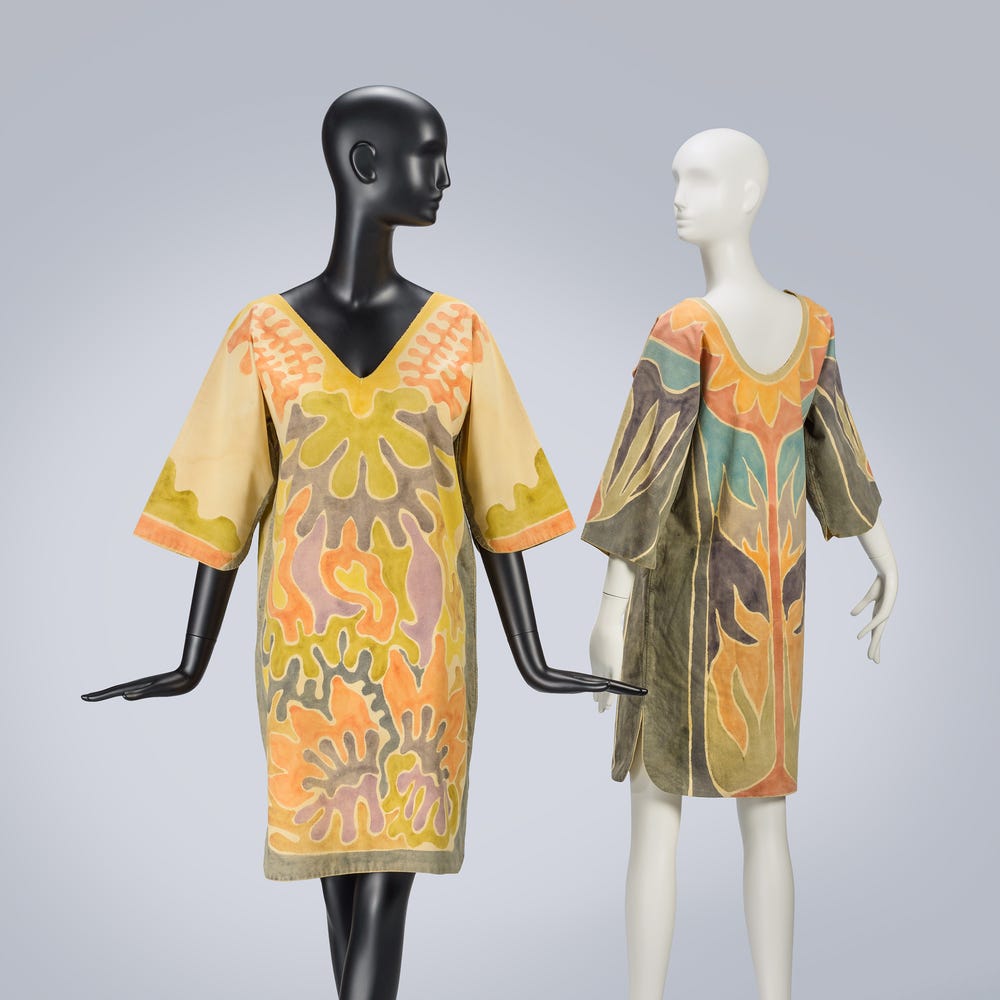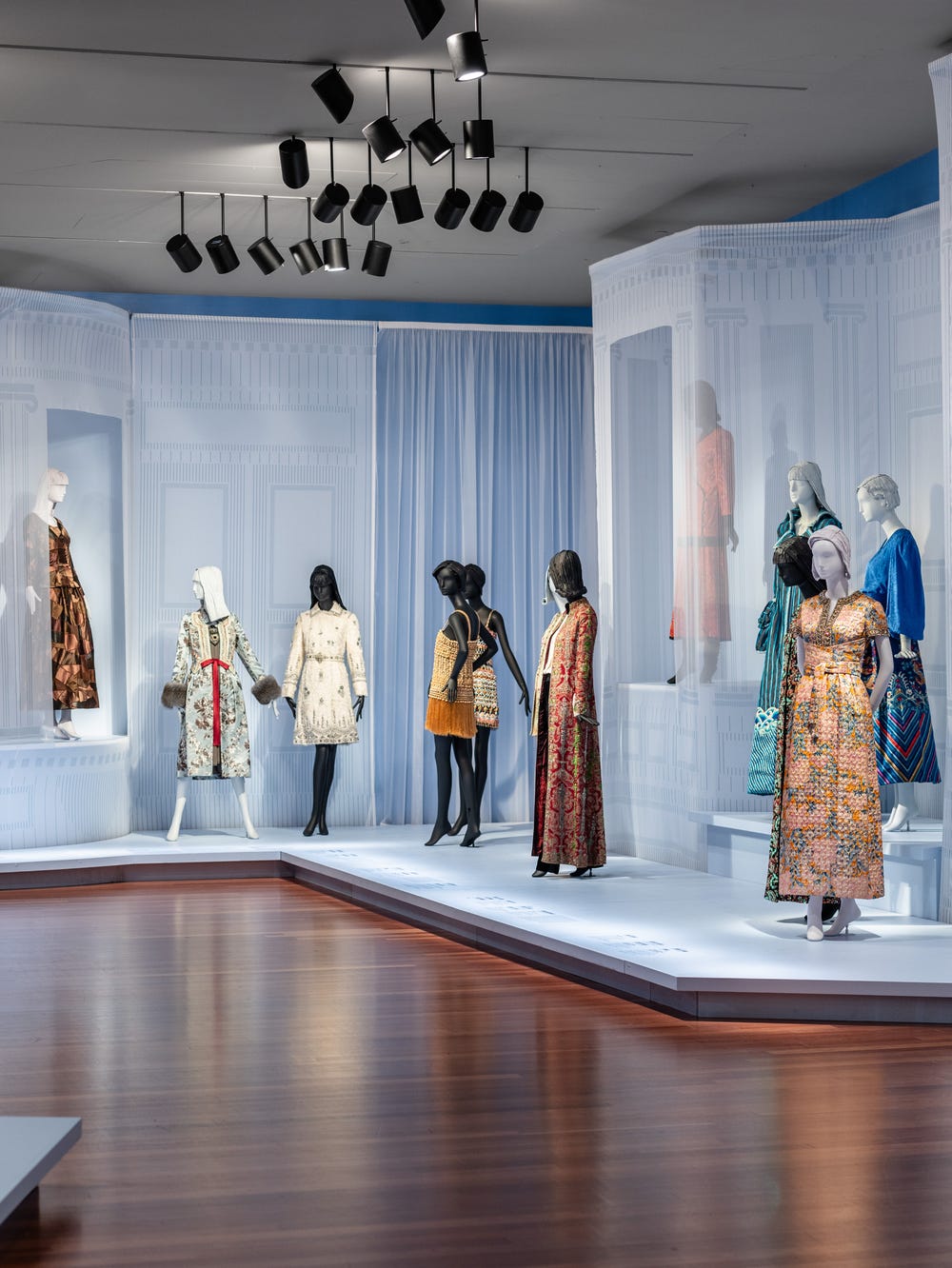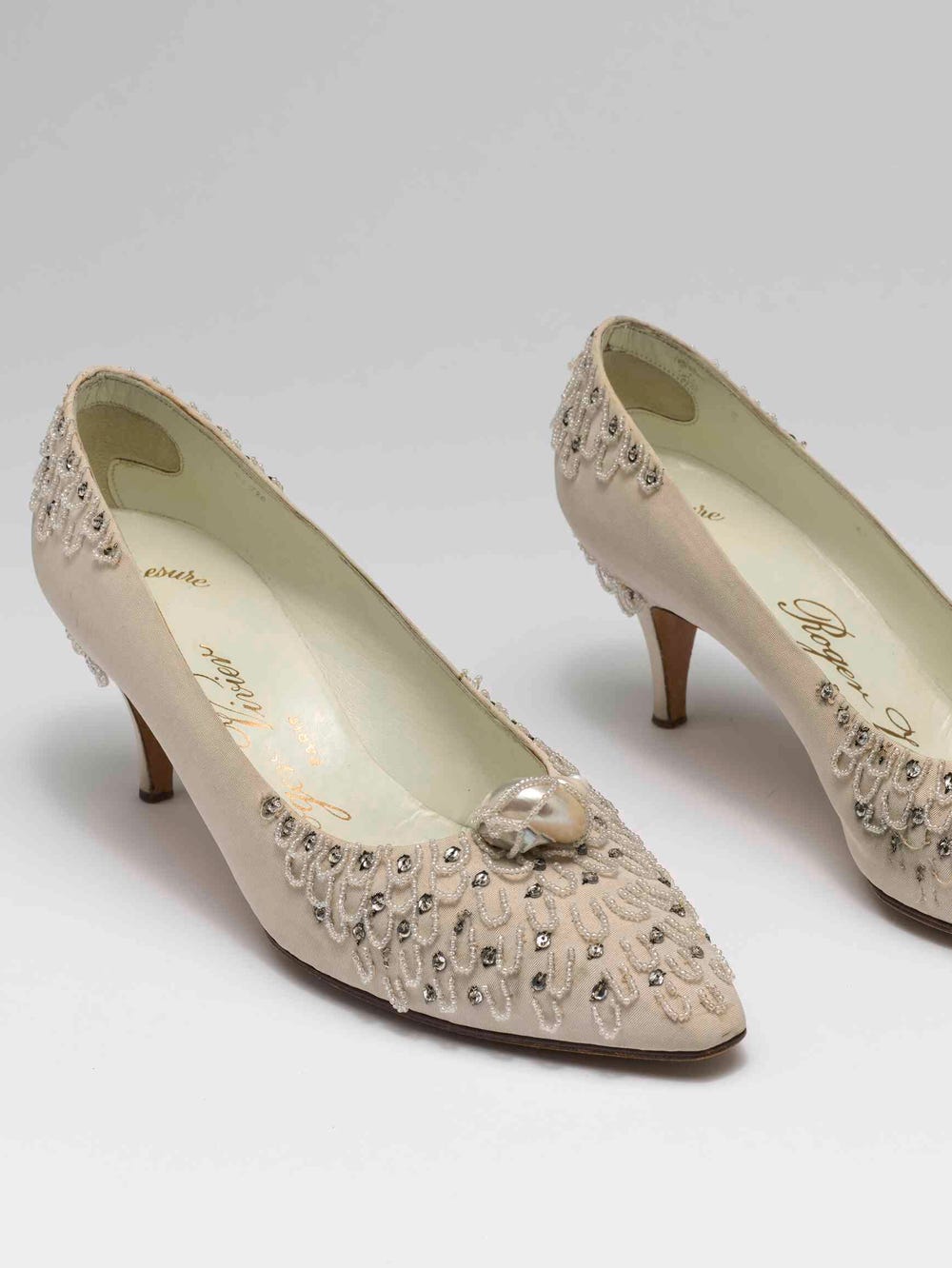Guo Pei’s Embroidered Universe: Dreamscapes
By Kristal Hale
May 12, 2022
Through her resplendently embroidered collections of couture fashion, Guo Pei has laid a golden thread for us to follow that is at once narrative and philosophical, traditional and futuristic. Much like historical embroidered motifs in both Eastern and Western cultures that incorporate symbolism through imagery and colors, Guo Pei’s gowns embody messages, mementos, and inspirations expressed through intricate stitches.
Although raised in China during the Cultural Revolution, a time when simple gray, blue, and olive-green garments were mandatory, Guo Pei absorbed her grandmother’s descriptions of fashionable garments from the pre-revolutionary era while helping her mother sew the family’s winter clothing. Relegated to sedate colors, she dreamed of wearing yellow, traditionally reserved for imperial dress. These formative childhood experiences inspired her passion for fashion and embroidery, leading her to study at Beijing Second Light Industry School, visit collections of traditional embroidery during trips to Europe and Southeast Asia, and found her couturier, Rose Studio.
Guo Pei, Himalaya, Ensemble, Spring/Summer 2020. Copyright ©️ Guo Pei, Asian Couture Federation. Photograph by Lian Xu. All rights reserved
Himalaya, Ensemble, Spring / Summer 2020 includes a radiating golden crown reminiscent of a halo surrounding a saintly head in an early modern painting, along with a gown contoured to suggest a vestment of the Catholic Church known as a chasuble. The passementerie edging in the form of pom-poms further suggests a European tradition. However, the viewer is transported away from Western signifiers by a veritable universe of Chinese embroidery techniques and Buddhistic imagery. “The West pays more attention to visual effects, while the East pursues delicacy,” Guo Pei observed. In this work, she balances both worlds, reimagining the silk shading stitch, eponymously named after the strands of fine silk floss traditionally used to create intricate floral and animal motifs. This technique appears on imperial Chinese robes, including pieces from the Liao Dynasty (916 – 1125 CE), and is a beloved and much-utilized stitch in historical Peranakan embroideries. Instead of silk strands, Guo Pei utilizes gold and silver metallic threads to create the delicate floral imagery and halos for the Buddhist deities (mirrored by the halo of the fashion ensemble). This daring reinterpretation of a traditional technique creates a shimmering surface that appears to emanate light, enhancing the religious symbolism of the embroidered imagery.
Gold and silver threads are part of the lineage of Chinese and world embroidery techniques. Embroidery with metal threads was historically made by couching wire, very thin metal strips, or wire or metal strip-wrapped fiber cores to a fabric. As the process was refined, economical artisans applied extremely fine gold leaf to organic substrates such as paper (in the East) and animal skin or gut (in the West), which were then wrapped around fiber cores and used as metal threads. Due to the inherent delicacy of these threads and the costliness of the gold and silver metal, it was most common to attach the metal threads to fabric with couching stitches. This technique held the threads in place with minimal manipulation, while allowing the maximum amount of precious material to remain on the surface of the garment. If traditional metal threads were overworked, an artisan was in danger of damaging and wasting costly materials.
The practice of utilizing couching stitches to attach contemporary metallic and metalized threads, which are more resilient than their traditional counterparts, is also seen in Guo Pei’s couture. However, by using metal threads for silk shading embroidery (among other methods), she has re-envisioned how materials and embroidery stitches can be combined, innovating a technique that has equal footing in the past and present.
Guo Pei, Da Jin (Magnificent Gold), 2005. Copyright ©️ Guo Pei, Asian Couture Federation. All rights reserved. Photograph by Randy Dodson, courtesy of the Fine Arts Museums of San Francisco
In Da Jin (Magnificent Gold), 2005, the thread continues. Requiring 50,000 hours to complete and an army of artisans, this gown with radiating panels imitating the sun is hailed as “the birth of haute couture in China” by the China National Silk Museum and is embraced by Guo Pei as a “personal masterpiece.” Embellished with lotus and other floral motifs in gold and silver metallic thread, rococo metal threads, and sequins, this dress was embroidered with couching stitches traditionally used for metal thread.
Guo Pei, An Amazing Journey in a Childhood Dream, Ensemble, 2007. Copyright ©️ Guo Pei, Asian Couture Federation. Photograph by Lian Xu. All rights reserved
Guo Pei employs a technique known as goldwork, which includes the traditional use of gold and/or silver metal threads along with an array of other metal materials. An Amazing Journey in a Childhood Dream, Ensemble, 2007, a pale pink dress lavishly embroidered with silver, nods to the English embroidery traditions of the 16th through 19th centuries, when elaborate metal wires were used to adorn aristocratic as well as military garments. The goldwork technique used for this dress varies from older Eastern and Western traditions in that it includes extremely fine metal tubing with a variety of decorative surface effects to create dimensional designs. The metal tubing can be cut to the precise dimension required for a form; it is then slipped onto a threaded needle and gently attached to the surface of a design. This process is repeated until the padded form of a leaf, for instance, is completely covered in shimmering gold or silver. The ensemble exhibits a plethora of these materials, including so-called pearl, bullion, and rococo threads, along with more traditional metallic threads with fiber cores.
Guo Pei, Legend of the Dragon, Ensemble, 2012. Copyright ©️ Guo Pei, Asian Couture Federation. Photograph by Lian Xu. All rights reserved
Guo Pei, Legend of the Dragon, Ensemble, 2012 (detail). Image by Kristal Hale
Although Legend of the Dragon, Ensemble, 2012, a maximalist minidress, is made with Guo Pei’s signature techniques, it also includes some unusual permutations, such as the forbidden stitch (see detail). Allegedly named for a stitch that was immensely popular in the Forbidden Palace (although the actual stitch predates the palace’s construction), this technique was traditionally created by densely clustering groups of pointillist embroidery, also referred to as seed stitch and French knots, into various motifs (the aforementioned stitches have nearly identical constructions but can vary slightly). Instead of closely clustering groups of forbidden stitches, Guo Pei employs them as punctuation marks in the plush centers of flower motifs, which are prepared with a ground of satin stitch and covered with diagonally laid filling stitches.
Guo Pei, L’Architecture, Ensemble, Fall/Winter 2018–2019
In a tonal shift, L’Architecture, Ensemble, Fall / Winter 2018 – 2019, is made of glistening silver threads applied with couching, chain stitch, stem stitch, and satin stitch to the surface of a dark chiffon silk. Inspired by Gothic and Romanesque architecture, embroidered spires embellished with Swarovski crystals and rhinestones stretch skyward along the vertical axes of the dress, emphasizing the elongated silhouette. Padded architectural elements held with an interlacing of crisscrossed stitches add further dimensionality to the surface. Satin stitches historically made with strands of silk to imitate the reflectance of satin weave are embroidered in a silver-black metallic thread.
Guo Pei, Garden of Soul, Ensemble, 2015. Copyright ©️ Guo Pei, Asian Couture Federation. Photograph by Lian Xu. All rights reserved
Guo Pei, Garden of Soul, Ensemble, 2015 (detail). Image by Kristal Hale
Guo Pei’s reimagining of gold and multicolored metallic thread as silk shading and satin stitch is an innovation that quite literally jumps off the cloth in Garden of Soul, Ensemble, 2015. Embellished with this signature technique, some of the embroidered flowers were carefully cut from the structural support fabric and allowed to seemingly float midair on strands of Swarovski crystals below the dress (see detail). Since the flowers could easily flutter and rotate with the movements of the wearer, it was necessary to employ a technique known as double-sided silk shading, in which the front and reverse sides of the embroidery are essentially identical. Double-sided silk shading is a painstaking and time-intensive technique, requiring advanced training and perseverance. Since metallic threads are trickier to manipulate into a smooth, cohesive unit than their silk counterparts, the subtle addition of these delicate flowers speaks to the talent at Rose Studio.
Guo Pei, Alternate Universe, Two Person Dress, Fall/Winter 2019/2020. Copyright ©️ Guo Pei, Asian Couture Federation. Photograph by Lian Xu. All rights reserved
Strands of metalized thread take on a dreamlike quality in Alternate Universe, Two Person Dress, Fall / Winter 2019 – 2020. Conjoined at the skirt, two bodices merge to become one gown. Conceived as a part of her Alternate Universe (2019 – 2020) series, the dress displays surrealistic imagery inspired by afterlife and reincarnation. Constructed of gauzy pineapple fiber (piña), this gown is made with steel wire, embroidered with gold and silver threads, raffia, goose feathers and embellishment with resin beads, Swarovski crystals, and rhinestones.
Guo Pei, Alternate Universe, Two Person Dress, Fall/Winter 2019/2020 (detail). Copyright ©️ Guo Pei, Asian Couture Federation. All rights reserved. Photograph by Randy Dodson, courtesy of the Fine Arts Museums of San Francisco
Three-dimensional, padded embroidery, also referred to as raised work or stumpwork, seems to spring from the dress in fantastical forms. A raven made of silk shading embroidery in radiant metallic threads flaps its wings, which transform from embroidery into jet-black bird feathers (see detail). Although this three-dimensional embroidery technique gained popularity in 17th-century England, Guo Pei takes it further, using it to cross the boundary between dreamscape and reality. Her embroidered bird seems to transform, lifting off the gown into flight.
Through her innovative use of golden threads and embroidery stitches, Guo Pei has created a universe that is at once traditional and futuristic, philosophical and whimsical. Her fantastical couture embodies messages, mementos, and inspiration that she absorbed throughout her life, from listening to her grandmother’s tales when she was a small child to embarking on her own adventures around the world. Unbound by the painterly fluidity of the embroidery stitch, her work embodies Eastern and Western traditions through imagery and precise technical stitches, juxtaposing geometric and floral shapes along with soft and rigid materials. By integrating the endless versatility of embroidery into her designs, Guo Pei looks to traditional iterations of both Chinese and European techniques, reimagining them in a confluence of couture with vibrantly innovative stitches.
Text by Kristal Hale, Andrew W. Mellon Conservation Fellow, the Metropolitan Museum of Art.
Guo Pei: Couture Fantasy is on view at the Legion of Honor from April 16 through September 5, 2022.
References
- Barnden, Betty. The Embroidery Stitch Bible. Tunbridge Wells, Kent: Search Press, 2017.
- Bayer, Anja, Lynette Sue-ling Gremli, and James C. Y. Watt. Dragons of Silk, Flowers of Gold: A Group of Liao-Dynasty Textiles at the Abegg-Stiftung. Edited by Regula Schorta. Riggisberg: Abegg-Stiftung, 2007.
- Browne, Clare, Glyn Davies, and M. A. Michael. English Medieval Embroidery: Opus Anglicanum. New Haven: Yale University Press, 2021.
- Gao, Hanyu. Chinese Textile Designs. London: Viking, 1992.
- Nosch, Marie-Louise, Feng Zhao, and Lotika Varadarajan. Global Textile Encounters. Oxford: Oxbow Books, 2015.
- Vogelsang-Eastwood, Gillian, and Willem Vogelsang. Encyclopedia of Embroidery from Central Asia, the Iranian Plateau and the Indian Subcontinent. London: Bloomsbury Visual Arts, 2021.
- Vogelsang-Eastwood, Gillian. Encyclopedia of Embroidery from the Arab World. New York: Bloomsbury Academic, 2016.
- Wang, Yarong. Chinese Embroidery. Tokyo: Kodansha International, 1987.
- Wanner-JeanRichard, Anne. Stickstiche. St. Gallen: Textilmuseum St. Gallen, 2014.
- Watt, Melinda, and Andrew Morrall, eds. English Embroidery from the Metropolitan Museum of Art, 1580–1700: ’Twixt Art and Nature. New Haven: Yale University Press, 2008.
- Zhao, Feng, Wengying Li, Juanjuan Chen, Nengfu Huang, and Hao Peng. Chinese Silks. Edited by Dieter Kuhn and James C. Y. Watt. New Haven: Yale University Press, 2012.
